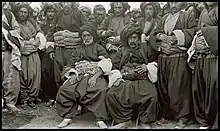Mangur (tribe)
Mangur is one of the largest Kurdish tribes of Eastern Kurdistan.They live in the district and cities of Sardasht, Piranshahr to Mahabad.[1]
Mangur was one of the Kurdish tribes in the Bolbas Federation.[2] The others were: Mâmash, Pirân, Zerzâ, Herki and Shekâk.

Mangurs practice Matrilineality. This was demonstrated through the Mangur Tribal chief had six wives , he gave his children surnames named after their mother. All Mangurs can trace their ancestral grandmother back to one of these six wives. Today Mangurs officially use surnames , however they still identify as being descendants belonging to one of these six families. Marriages were often political, and it was common to marry outside of their tribe with other local tribes. Mangurs also have a stereotype of being very direct with their speech.
History

In the winter of 1928-29 the Mangur, the Mâmash and other tribes rebelled against Reza Shah and occupied Sardasht though they lacked the forces to extend the revolt more widely.[3] [4] The Mangur were among the tribes to initially back the Soviet-backed Republic of Mahabad in 1946. However support for the republic soon fell after the withdrawal of Russia. The Mangur Tribe, and other surrounding tribes withdrew their support. [5]
The origins of the Mangurs, are unknown. Many have fair skin, blonde hair and striking blue eyes. Some tribes people have claimed that they have Russian roots, However there is no historical evidence to support this. Mangurs continue to pass down their Matrilineal line heritage. Referring to their ancestral grandmother as their family name. Since the introduction of surnames in Iran, Mangurs adopted using surnames, however still using their maternal family sub groups identities amongst themselves. Some Mangur Families being run by women and can be considered as Matriarchal, Though typically most Mangur Families were run by men and therefore considered Patriarchal however were still Matrilineal and had better status of women compared to other surrounding peoples.[6] This tradition of Matrilineality has also been adopted by many non-Mangur Kurdish tribes who were subjects to the Mangurs throughout the years though it's currently only actively practiced by Mangurs and other smaller clans, however other non-Mangur Kurdish tribes and families in Mukriyan remain being named after a female ancestor.[7]
References
- "KURDISH TRIBES – Encyclopaedia Iranica". www.iranicaonline.org. Retrieved 2019-10-20.
- Minorsky, V. (1957). "Mongol Place-Names in Mukri Kurdistan". Mongolica. 19 (1): 75. JSTOR 609632.
- David McDowall (2004-05-14). A Modern History of the Kurds. I.B.Tauris. ISBN 978-1-85043-416-0.
- Stephanie Cronin (2007-01-24). Tribal Politics in Iran: Rural Conflict and the New State, 1921-1941. Routledge. pp. 116–. ISBN 978-1-134-13801-2.
- E. O'Ballance (1995-12-18). The Kurdish Struggle, 1920-94. Palgrave Macmillan UK. pp. 29–. ISBN 978-0-230-37742-4.
- Abdurrahman Sharafkandi. Çêştî Micêvir.
- Minorsky, V. (1957). "Mongol Place-Names in Mukri Kurdistan". Mongolica. 19 (1): 75. JSTOR 609632.